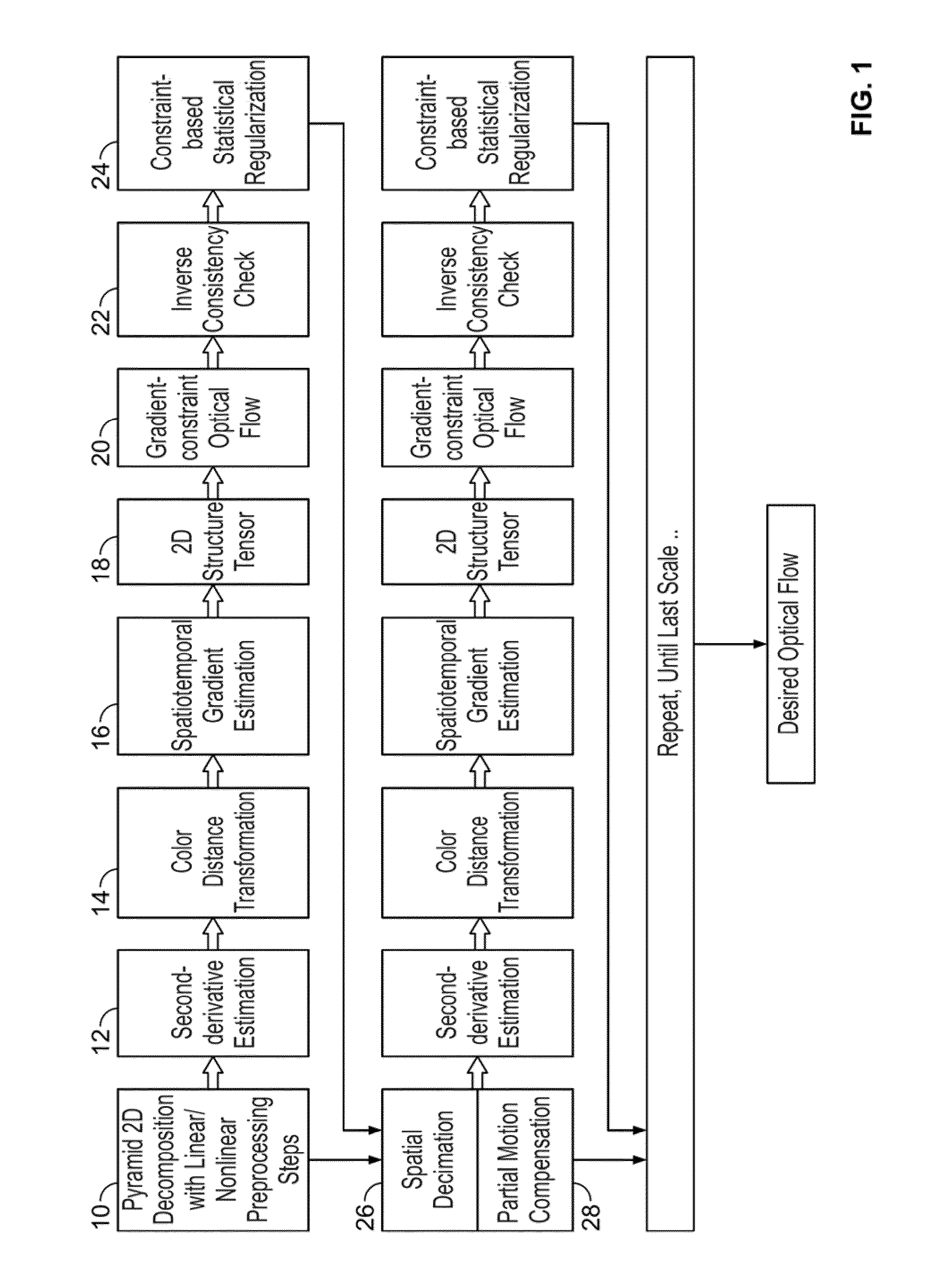Known methods for calculating optical flow encounter several stumbling blocks.
Many methods suffer from low accuracy—motion vectors may not reflect the actual motion; others lack precision—motion vectors are limited to a precision on the order of a
single pixel or a particular fraction of a pixel in a limited region; still others suffer from a lack of density—single motion vectors may be available only for entire regions or blocks of an image, instead of on a per-pixel basis.
Additionally, widely varying computational and
memory bandwidth costs accrue to many, if not all, of these methods.
Block-based
matching methods are frequently used in video coding and other real-time tasks due to their relatively small complexity and intuitive nature.
However, block-based
matching methods are limited in
dynamic range by the extent of a block search, limited in precision by the
granularity of the block search, limited in the accuracy of an interpolator used to sample pixel values at the sub-pixel level, and limited in accuracy due to what is known as the “aperture problem.” The “aperture problem” occurs when a block matching method estimates a wrong
motion vector due to lack of sufficient differences between blocks with no texture or edge differences along a gradient, which results in a
motion vector at a local minimum instead of the global minimum.
Prior art block-based optical flow and motion-
estimation methods suffer from the aperture problem, which is further exacerbated in block based methods that attempt to reduce search complexity by using multi-scale or other techniques to reduce the search depth and breadth from that of an exhaustive search.
As a result, motion-compensated block-based methods have found widespread application in the field of video coding, at the expense of reduced accuracy.
However, phase-based
motion estimation is performed in the
frequency domain and acts upon the phase information computed therein, and therefore requires input images to be transformed to the 2D
frequency domain, a very computationally expensive process for video.
Unfortunately, these techniques still involve relatively applying large filter-banks sequentially to each pixel, resulting in a
high memory bandwidth requirement with only a modest decrease in relative overall computational complexity and
memory bandwidth requirements.
121-130 (hereinafter “Lucas and Kanade”), produce dense optical flow fields on a per-pixel basis, but cannot reliably generate motion vectors with magnitudes greater than a
single pixel, and suffer from inconsistent flow fields in the presence of severe
noise, object occlusions, and complex non-
translational motion.
The method and
system described in U.S. Pat. No. 5,680,487 overcomes the single-pixel limitation by using a multi-scale method, but is not robust in the presence of
noise and / or occlusions.
A drawback to the approach used by Nagel and Enkelmann is that the gradient-constancy constraint is violated under complex motion models such as scaling and rotation.
Additionally, the
estimation of discrete-space spatio-temporal derivatives under the scheme of Nagel and Enkelmann has proved to make error-free implementation problematic.
The foregoing prior art optical flow methods suffer from mathematical
instability in the presence of noise and occlusions, and are further impaired by a consistently-applied, but very coarse approximation of the actual spatio-temporal gradient calculation upon which the rest of the estimation process is dependent (such as the central-differences method, which completely ignores the sampled values, at the actual sample location under analysis).
These coarse approximations lead to unnecessary errors in the initial estimation process, forcing subsequent stages to
clean up or reject estimated values based upon further imperfect
heuristics, thresholds, or constraints, all accomplished at a significant expense of further complexity.
The foregoing prior art optical flow methods further suffer from one or more of the problems of (1) high computational complexity, (2) noise susceptibility due to numerical
instability, (3) failure to account for occlusions of pixels from one frame to the other, (4), limited
range of motion, (5) inability to accurately calculate a flow field in the presence of changes of brightness due to lighting changes in the scene or of objects in the scene, and / or (6) accuracy problems due to incorrect or inadequate assumptions in the model of the discrete-sampled gradient field.
 Login to View More
Login to View More  Login to View More
Login to View More 


